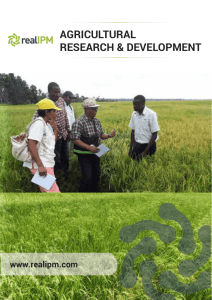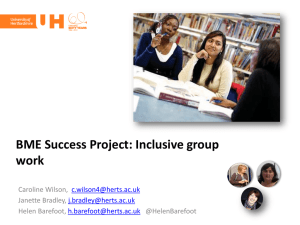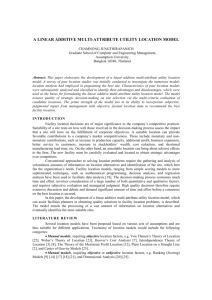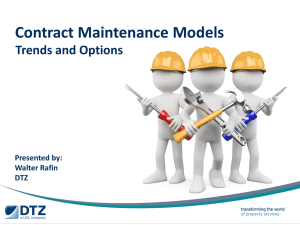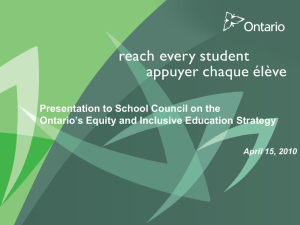Inclusive Education: competences for teacher training
advertisement
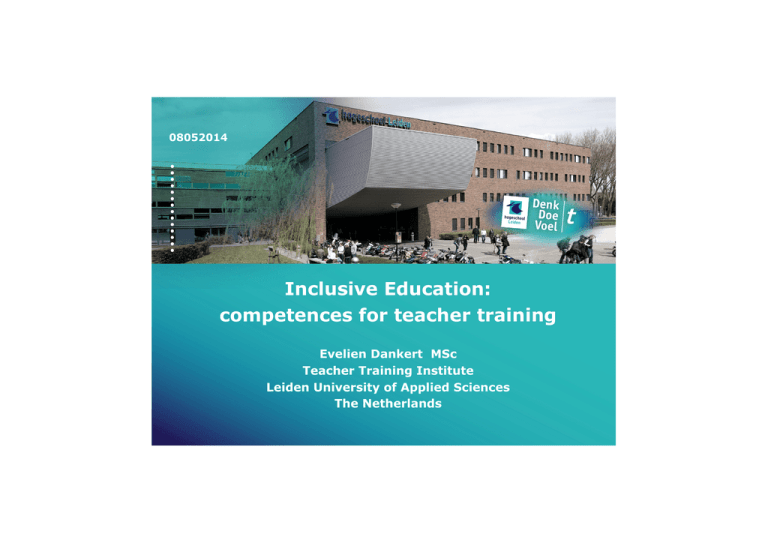
08052014 Inclusive Education: competences for teacher training Evelien Dankert MSc Teacher Training Institute Leiden University of Applied Sciences The Netherlands Our goal in teacher training in relation to developments on inclusive education To train teachers that are able to meet the educational needs of all children in the classroom, not to forget the gifted children. The bachelor programme is 4 years. • We offer a general teacher training programme for all our students over a period of 3,5 years • In addition, students choose a specialized programme (a minor for 30 European Credits), one of the options is de minor Inclusive Education (1 semester) • The teacher training course to become a Special Needs Educator consists of an extra year on top of the standard training of 4 years. Teachers’ concerns on properly responding to special educational needs, are the strongest in the following situations: Behavioural problems Gifted children Visually and hearing impaired Severe learning problems Down syndrome (Jettinghof & Grootscholte, 2013; Van Klaveren, 2011; Olbers, 2012; Oudheusden & Mol Lous, 2013; Smeets& Ledoux, 2013) The minor on Inclusive Education • Based on research by our research team • Practice based evidence: using knowledge of teachers, students, special needs experts and parents • Accessible for all students (bachelor) in the field of - primary and secondary education or - working with children in a non-educational environment but still focused on development and coaching (like a daycare) • High level of interaction between theory and practice Research results used for the minor on Inclusive Education The Leiden & Rotterdam University of Applied Sciences is active in conducting research on Inclusive Education. We use the results from this research for our teacher training programme on Inclusive Education: 1. Van Oudheusden (2013) How do teachers succeed in providing inclusive education? 2. Haenen & Mol Lous (2014) How can (future) teachers in primary schools meet the educational needs of gifted children? 3. Mol Lous & Van den Steenhoven (2013) Personal competences and self-esteem of children related to teacher-child interactions. Marja van Oudheusden (2013) How do teachers succeed in providing inclusive education? RECOMMENDATIONS 1. Focus on communication and conversations 2. Focus on the solutions that children present to them 3. Work on what works (WOWW) and focus on positive behaviour 4. Adapt teaching to the childrens’ needs instead of strictly follow the curriculum or methods Janine Haenen & Annemieke Mol Lous (2014) How can (future) teachers in primary schools meet the educational needs of gifted children? RECOMMENDATIONS: 1. Pay attention to characteristics and educational needs 2. Work with appropriate teaching materials 3. Coach these children and their meta-cognitive skills in a Solution-Focused way Annemieke Mol Lous & Marije van den Steenhoven (2013) Personal competences and self-esteem of children related to teacher-child interactions. RECOMMENDATIONS for teacher training: Awareness among the students on the importance of: • high secure learning environment • secure teacher-child relationship • positive atmosphere • quality classroom management • quality of instruction • taking child perspective • conceptual development Solution focused approach as a technique for inclusive education Empowerment of the child: listening to the child, understanding the needs and using the talents. 1. Don’t mend something that isn’t broken 2. See what works and do more of that 3. When something doesn’t work, try something different 4. Learn it to others / from each other From research into practice: - Start from the the child’s needs (listen, don’t fill in) - Acknowledge talents / WOWW / positive (talent model) - Approach the parent as a partner (understand an use the context) Techniques used for solution focused education ! ! Techniques we use: • SF-conversation • Scale question • Wonder question • Use resources • Good examples • Kids’ skills 1. zet problemen om in vaardigheden die de leerling kan leren 4. laat de leerling zijn/haar vaardigheid een naam geven. 2. bespreek met de leerling welke vaardigheden hij/zij wil leren. 3. laat de leerling zien welke voordelen het hem/haar zelf oplevert, als hij/zij de vaardigheid beheerst. 5. vraag de leerling een krachtig symbool te kiezen, dat hem kan helpen bij het leren van deze vaardigheid 6. help de leerling supporters te vinden 7. vraag aan de supporters de leerling te vertellen, waarom zij er op vertrouwen dat hij/zij de vaardigheid kan leren. 8. maak met de leerling een plan hoe hij/zij zijn/haar succes gaat vieren, als hij/zij deze vaardigheid beheerst. 9. vraag de leerling je te laten zien hoe hij/zij zich gedraagt als hij/zij de vaardigheid heeft geleerd. 10. Help de leerling aan anderen uit te leggen welke vaardigheid hij/zij aan het leren is. 11. geef de leerling kansen om zijn/haar vaardigheid te oefenen, zodat hij/zij kan laten zien hoe goed hij al is. 12. laat de leerling je vertellen hoe hij/zij er aan herinnerd wil worden, als hij de vaardigheid vergeet. 13. vraag de leerling alle supporters te bedanken wanneer het tijd is voor zijn/haar feestje 14.geef de leerling de kans om zijn/haar vaardigheid aan anderen te leren. 15. overleg met de leerling welke nieuwe vaardigheid hij nu wil leren. ! ! Furman Måhlberg & Sjöblom First example of a developed product First example of a developed product Blue = angry Silver = energetic Red = happy Brown = sad White = scared Stones = other / unfamiliar emotions Second example of a developed product Inclusive education A positive and encouraging attitude, recognition and acceptance of the child, really see the child and talk with him / her, focus on talents and make the child responsible for his / her own learning. Inclusive education for all The minor gives the students the possibility to work abroad, we work together with schools and universities in Mali, Kenya, Ethiopia and Uganda.
